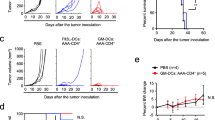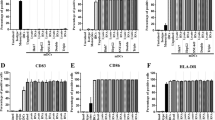Abstract
After the discovery of interleukin-2 (IL-2), lymphokine-activated killer (LAK) cells, tumor-infiltrating lymphocytes (TILs), and cytotoxic T lymphocytes (CTLs) sensitized with the mixed lymphocyte-tumor culture (MLTC) system have been conducted in adoptive immunotherapy (NT) trials during past 15 years. Although the overall response rate of tumor shrinkage was marginal (9%), locoregional administration of TILs for malignant effusions was effective (77%) for a decrease or disappearance of the effusions even in terminally-ill patients, resulting in an improvement of QOL. Recent advances for molecular understanding of antigen presentation and recognition have promoted us to enhance the efficacy of AIT by using cultured dendritic cells (DCs) for generating antigen-specsc CTLs in vitro. The peptidepulsed DC-activated killer (PDAK) cells showed tumor recognition against antigen-expressing cells, and were efficiently propagated with the IL2 plus immobilized anti-CD3 antibody (IL-2/CD3) culture system. Clinical trials using PDAK cells against patients with lung metastases are now progressed, in which peptides suitable for generating CTLs were chosen in individual patients using the method designated as host-oriented peptide evaluation (HPOE) approach. Moreover, DCs were introduced with tumor-derived RNA, which was amplied with the T7 promoter system, and then were used for stimulating lymphocytes. The tumor RNA-introduced DC-activated killer (TRiDAK) cells showed tumor-specific interferon-gamma spots even in a patient in whom we failed to generate PDAK cells using DCs and peptides, suggesting that the clinical trial of AIT using TRiDAK ceIls is warranted for the treatment of patients with metastatic cancer. Thus, more understanding of antigen-presentation and -recognition mechanisms and immune regulation systems may promote clinical applications of AIT to establish a novel modality of cancer treatment.
Similar content being viewed by others
References
Taniguchi T, Matsui H, Fujita T, et al.: Structure and expression of a cloned cDNA for human interleukin-2. Nature 302: 305–310, 1983.
Rosenberg SA, Lotze MT, Muul LM, et al.: Observation on the systemic administration of autologous lymphokine-activated killer cells and recombinant interleukin-2 to patients with metastatic cancer. N. Engl. J. Med. 313: 1485–1492, 1985.
Rosenberg SA, Packard BS, Aebersold PM, et al.: Use of tumor infiltrating lymphocytes and interleukin-2 in the immunotherapy of patients with metastatic melanoma. A preliminary report. N. Engl. J. Med. 319: 1676–1650, 1988.
Kiessling R, Wasserman K, Horiguchi S, et al: Tumor-induced immune dysfunction. Cancer Immunol. Immunother. 43: 353–362, 1999.
Grimm EA, Mazumder A, Zhang HZ, et al.: Lymphokine-activated killer cell phenomenon. Lysis of natural killer-resistant fresh solid tumor cells by interleukin 2-activated autologous human peripheral blood lymphocytes. J. Exp. Med. 155: 1823–1541, 1982.
Parkinson DR, Fisher RI, Rayner Ah, et al.: Therapy of renal cell carcinoma with interleukin-2 and lymphokine-activated killer cells: phase II experience with a hybrid bolus and continuous infusion interleukin-2 regimen. J. CIin. Oncol. 8: 1630–1636, 1990.
Kimura H, Yamaguchi Y A phase III randomized study of interleukin-2 lymphokine-activated killer cell immunotherapy combined with chemotherapy or radiotherapy after curative or noncurative resection of primary lung carcinoma. Cancer 80: 42–49, 1997.
Takayama T, Sekine T, Makuuchi M, et al.: Adoptive immunotherapy to lower postsurgical recurrence rates of hepatocellular Carcinoma: a randomised trial. Lancet 356. 802–507, 2000.
Kono K, Takahashi A, Ichihara F, et al.: Prognostic significance of adoptive immunotherapy with tumor-associated lymphocytes in patients with advanced gastric cancer: a randomized trial. Clin. Cancer Res. 8: 1767–1771, 2002.
Rosenberg SA, Spiess P, Lafreniere R: A new approach to the adoptive immunotherapy of cancer with tumor-infiltrating lymphocytes. Science 233: 1318–1321, 1986.
Freedman RS, Edwards CL, Kavanagh JJ, et al.: Intraperitoneal adoptive immunotherapy of ovarian carcinoma with tumor-infiltrating lymphocytes and low-dose recombinant interleukin-2: a pilot trial. J. Lmmunother. 16: 198–210, 1994.
Ravaud A, Legrand E, Delaunay MM, et al.: A phase I trial of repeated tumor-infiltrating lymphocyte (TIL) infusion in metastatic melanoma. Br. J. Cancer 71: 231–336, 1995.
Ratto GB, Zino P, Mirabelli S, et al.: A randomized trial of adoptive immunotherapy with tumor infiltrating lymphocytes and interleukin-2 versus standard therapy in the postoperative treatment of resected nonsmall cell lung carcinoma. Cancer 78: 244–251, 1996.
Aruga A, Yamauchi K, Takasaki K, et al.: Induction of autologous tumor-specific cytotoxic T cells in patients with liver cancer. Int J. Cancer 49: 19–24, 1991.
Stevens EJ, Jacknin L, Robbins PF, et al.: Generation of tumor-specific CTLs from melanoma patients by using peripheral blood stimulated with allogeneic melanoma tumor cell lines. Fine specificity and MART-1 melanoma antigen recognition. J. Immunol. 154: 762–771, 1995.
Soda H, Koda K, Yasutomi J, et al.: Adoptive immunotherapy for advanced cancer patients using in vitro activated cytotoxic T lymphocytes. J. Surg. Oncol. 72: 211–217, 1999.
Pawelec G, Xees RC, Kiessling R, et al.: Cells and cytokines in immunotherapy and gene therapy of cancer. Crit. Rev. Oncog 10: 83–127, 1999.
Qian S, Zhang T, Chen S: Enhanced expression of HLA class I molecules in human hepatocellular carcinoma cells transduced with gamma-interferon gene. Chin. Med. J. (Engl) 111: 319–223, 1998.
Hirst WJ, Buggins A, Darling D, et al.: Enhanced immune costimulatory activity of primary acute myeloid leukaemia blasts after retrovirus-mediated gene transfer of B7.1. Gene Ther. 4: 691–699, 1997.
Yamaguchi Y, Ohta K, Shimizu K, et al.: Generation of cytotoxic effector lymphocytes by MLTC using tumor cells genetically modified to secrete interleukin-2. Anticancer Res. 21: 669–677 2001.
Romani N, Gruner S, Brang D, et al.: Proliferating dendritic cell progenitors in human blood. J. Exp. Med. 180: 83–93, 1994.
Ohta K, Yamaguchi Y, Shimizu K, et al.: Novel system for generating cytotoxic effector lymphocytes using carcinoembryonic antigen (CEA) peptide and cultured dendritic cells. Anticancer Res. 22: 2597–2606, 2002.
Kawabuchi Y, Yamaguchi Y, Ohshita A, et al.: Host-oriented peptide evaluation using whole blood assay for generating antigen-specific cytotoxic T lymphocytes. Anticancer Res.(in press)
Nair SK, Morse M, Boczkowski D, et al.: Induction of tumor-specific cytotoxic T lymphocytes in cancer patients by autologous tumor RNA-transfected dendritic cells. Ann. Surg. 235: 540–549, 2002.
Heil SG, Kluijtmans LA, Spiegelstein O, et al.: Gene-specific monitoring of T7-based RNA amplification by real-time quantitative PCR. Biotechniques 35: 502–504, 506–508, 2003.
Hirohashi Y, Torigoe T, Maeda A, et al.: An HLA-A24-restricted cytotoxic T lymphocyte epitope of a tumor-associated protein, surviving. Clin. Cancer Res. 8: 1731–1739, 2002.
Nair S, Boczkowski D, Moeller B, et al.: Synergy between tumor immunotherapy and antiangiogenic therapy. Blood 102: 964–971, 2003.
Dudley ME, Wunderlich JR, Robbins PF, et al.: Cancer regression and autoimmunity in patients after clonal repopulation with antitumor lymphocytes. Science 298: 850–854, 2002.
Clay TM, Custer MC, Sachs J, et al.: Efficient transfer of a tumor antigen-reactive TCR to human peripheral blood lymphocytes confers anti-tumor reactivity. J. Immunol. 163: 507–513, 1999.
Pedley RB, Sharma SK, Hawkins RE, et al.: Antibody-directed enzyme-prodrug therapy. Methods Mol. Med. 90: 491–514 2004.
Author information
Authors and Affiliations
Corresponding author
Rights and permissions
About this article
Cite this article
Yamaguchi, Y., Ohshita, A., Kawabuchi, Y. et al. Adoptive immunotherapy of cancer using activated Autologous lymphocytes-current status and new strategies-. Hum Cell 16, 183–189 (2003). https://doi.org/10.1111/j.1749-0774.2003.tb00152.x
Published:
Issue Date:
DOI: https://doi.org/10.1111/j.1749-0774.2003.tb00152.x




